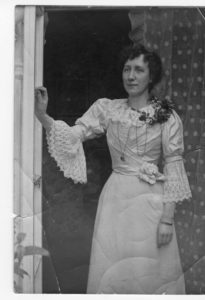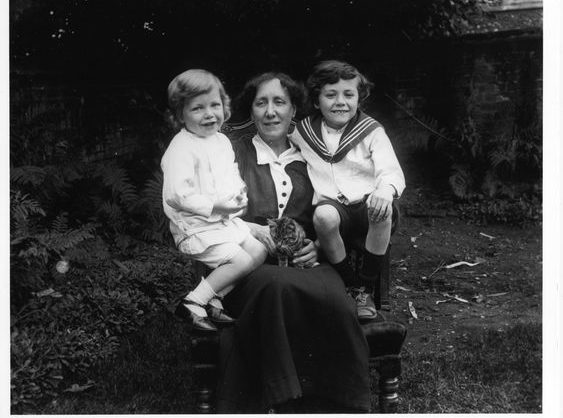This is a post by Judy Golding Carver, William Golding’s daughter and CEO of William Golding Limited. An earlier version of this piece was published as Judy Carver, ‘William Golding’s Mother’ published in Writers and Their Mothers, edited by Dale Salwak, 2018, Palgrave Macmillan, reproduced with permission of Palgrave Macmillan and Springer International Publishing AG.
A small girl runs along the clifftop. She is about seven, and in one hand she carries a covered enamel pitcher. It is full of cream from the farm. She and the rest of the family will have it with late summer blackberries. The day is bright though breezy — this is, after all, the north coast of Cornwall. But the ground is not as gentle as it looks. A tussock of grass trips her, throws her to the ground, and spills the cream. It spreads in the dirt, useless.

Grandma told me this story often, perhaps forgetting I had heard it before, but I think more likely re-living it herself. Strangely, she would smile as she did so. Her childhood was very vivid to her even in old age (she was seventy-four when I was born). Cornwall and its countryside, its coast, and its legends were a large part of her life, especially her imaginative life. During the half-century of her marriage in landlocked, chilly Marlborough, she had the local Newquay paper sent up to her every week. The papers arrived rolled into cylinders, wrapped in brown paper, and she would open them eagerly. She told many Cornish stories, but these were generally too full of the supernatural to get past my parents’ anxious censorship.
Her parents, Thomas and Mary Elizabeth Curnoe (née Husband), married in February 1869. Their first child, a boy called John, was born four days after the wedding. Grandma was born in November 1870, when the little boy would have been nearly twenty-two months. But he had died eight weeks earlier, of scarlatina.
My grandmother’s birth certificate does not give her a name, and I suppose one should hesitate to interpret that fact. Eventually she became Mildred Mary Agatha, and the photos we have of her as a child make much of her. She is nicely dressed, in the pleated, swagged and cluttered costumes of the period, and – possibly for photographic reasons – she looks very straight and unflinching at the camera. And we know from her own account that she ran happily around the countryside near Newquay. As an old woman she still hankered after the windswept cliff tops. This suggests her childhood did contain happiness. There may not have been many toys – she was shyly appreciative of the dolls’ house my grandfather made me, and no dolls of her own survived. Perhaps they were handed on to her sister. However, there were definitely books; once at Marlborough I was reading Little Women, and she said to me
‘Of course, I always liked Jo best.’
Poor Grandma – I looked up at her wrinkled face and hid my incredulity that someone so ancient had actually read Louisa May Alcott as a child. I hope she didn’t understand. And I am so pleased she liked Jo best. Did she see herself as Jo? My father’s imagined portrait of her as a young woman (long before he knew her) is reminiscent:
She was a gaunt, leggy, humourous [sic] girl, I fancy, dark-haired and striking but not pretty.
We do have a photograph, a family group in which she is about twenty-five or -six, and I can see the humorous quality – she looks quite satirical. Perhaps the photographer has made some comment about her. And she does look tall compared with the others, though in fact like all our family she was rather short. She stands at the back, and her face is kind rather than pretty.
As a child and young woman, she had piano lessons; she played all her life. I remember her playing Beethoven’s Moonlight Sonata. She and my grandfather Alec Golding played duets before they were married. He was a very reasonable violinist; and from somewhere in that strange Newquay home she produced a violin – a good one – and gave it him. What schooling she had was local. Until she met my grandfather, the furthest she had been from Newquay was Modbury in Devon, to visit her aunt.
Grandma was born in the village of Crantock, across the river Gannel from Newquay, in the Old Albion pub where her grandmother was licensee. My father did not know until after her death that she was born in a pub. She and my grandfather were teetotal, and anyway the raffishness of the idea would not have pleased either of them. My father comments admiringly, ‘She carried that secret to the grave, with all the hardness and more success than Lady Dedlock [from Bleak House].’
The 1870s were a bad time in Cornwall. Cornish tin and copper could not compete with the cheaper discoveries in South America. Harsh and dangerous as mining was, the lack of it was terrible for many Cornish families. No sooner had the mining collapsed than the fishing industry began a long decline as well. My grandmother’s father, Thomas Curnoe, was a mining engineer, and soon after her birth in 1870 he took long, unpredictable trips to mines in distant parts of the world – to the western United States, Ballarat in Australia, and maybe South America. Family legend says it was a good thing he went – he and his wife quarrelled so violently that one of them might have murdered the other.
Presumably they had married because of the imminent birth of their first child. It’s hard to think of any other reason for the closeness of the two events. No doubt there had been pressure from her parents. My father believed that his ancestors, particularly the female ones, were tenacious defenders of the fragile respectability of their families, struggling against the chaos that would overwhelm them if they let things slip.
So, by the time the little boy died, my great-grandmother was irrevocably tethered to her husband by yet another child – a child she may have resented. This is a grim beginning for Grandma’s life, with the death of her little brother, her parents’ volatile emotions, the decline of mining and fishing, and Thomas Curnoe’s unpredictability, let alone his failure to provide for the family. To support their daughter, her parents William and Mary Husband purchased a boarding house in Newquay — a tall, gaunt house on Mount Wise, which is a long, narrow road up above the town and harbour, with sea views. The house was named Karenza, the Cornish word for charity or love – I hope it’s too cynical to see this as a family joke. They had caught the tide of the next big thing in Newquay – tourists. The railway was already there, originally designed for mining and fishing. Newquay, with its glorious beaches and picturesque, somewhat disused harbour was a good holiday destination. A small building boom began.

Grandma’s mother had a reputation as a fierce woman, often full of anger — though my father remembers her buying him another cinema ticket when he, as a small boy, had gone to the local cinema in Newquay and had naturally lost the first one. Revealingly, he seems to have felt that such kindness was uncharacteristic. The idea of her quarrelling with her husband to the point of violence was something he accepted as possible. He also remembers a terrible scene at Karenza when Grandma was giving him a bath. He was aged about two, and he recalls that the bathroom was ‘one of Karenza’s glories’. Grandma had allowed him to play – to slide down the long slope at one end of the bath, landing in a swoosh and a great soapy wave at the other end. My great-grandmother burst in, ‘uttering bloody knives’, he says. Grandma sank under the attack to a diminished and frightened figure, cowed by her own mother’s rage. She was described to me by her niece as a frightened woman, frightened of her mother.
My grandmother did eventually have three more siblings: two brothers Tom and Will, and a much younger and very beloved sister Mary Victoria Estie, always called by the last of these names. But the little boy who died in October 1870 seems to have preoccupied her. Many decades later, a married woman of thirty-five, she was pleased that her own first child, Jose, was born in 1906 on the anniversary of her brother’s death.

To my father, Estie was the family beauty. She had, he said, two handfuls of beauty, and one of them was the handful my grandmother should have had. For him, and for our family, the beauty of a woman was a huge thing – and its absence a potent source of pain. My grandmother’s lack of it was for my father the tragedy of her life, and a source of that deep disappointment he saw in her. I don’t know whether this is true. Maybe she didn’t mind. She and the beautiful Estie were said to be particularly fond of each other. But then emotions in a family are rarely simple. My father may also have remade her in terms of his own preoccupations which were often of pain and humiliation. Beauty meant a lot to him, and he was very proud of my mother’s wonderful looks. He was, after all, a novelist and had thirty-three years after his mother’s death in which to reimagine her.

Was Grandma’s marriage an escape? She met my grandfather when he got a teaching job in Newquay and was booked into Karenza as a paying guest. This was in 1900. Their marriage took place in January 1906, and my father puzzles about the delay — he and my mother Ann got married in 1939 five months after they met. Was Grandma doubtful about her prospective husband? Was she weighing up an escape from Karenza, and the life of the put-upon daughter, versus marriage to someone she was probably not in love with? It’s not an unusual – or unliterary – choice. Besides, she was thirty-five to Alec’s twenty-nine, and my father reported that she felt she was past it. But I don’t know whether this comes from anything other than his novelist’s imagination. Maybe they were, as my grandfather Alec says in his diary, patiently waiting till he got a good enough job.
They married in Truro Cathedral and the photographs of the occasion make everyone, except the luscious Estie, look defensive and slightly startled. Grandma is in a splendid white dress, Alec uncomfortably defiant in a suit. On the marriage certificate Grandma slices five years off her age.
Following their marriage, Alec and Mildred moved permanently to Marlborough, Wiltshire. We’ll explore this in Part 2…


